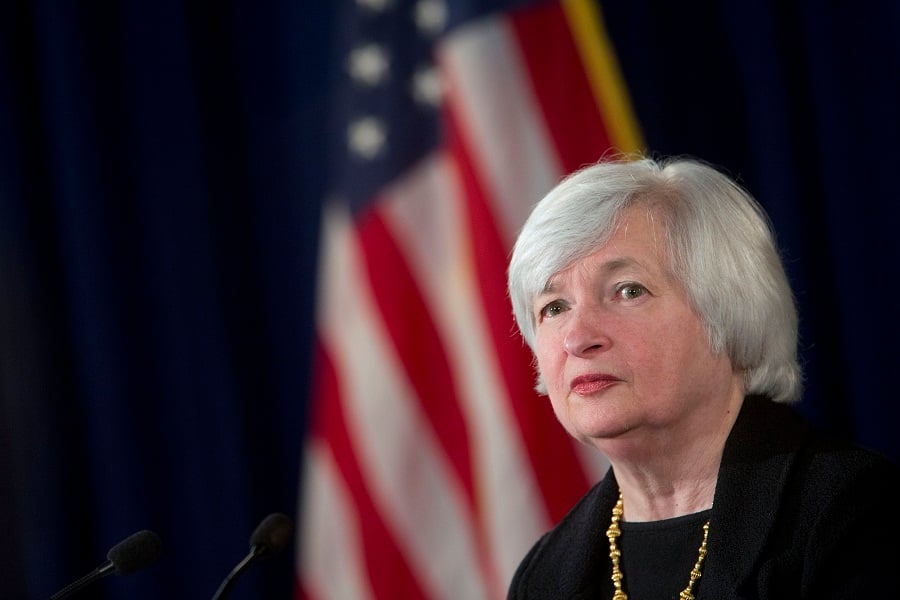Last week's volatility in the markets, highlighted by further implosions in the high-yield and energy segments, won't deter the Federal Reserve from raising interest rates on Wednesday. But the turmoil complicates the central bank's communications challenge, particularly the need to wrap the hike in heavily conditional and responsive packaging.
Three months ago, the Fed faced a similar set of circumstances: Markets were unsettled by concerns about Chinese growth, sharply lower oil prices and pockets of illiquidity, which all tightened financial conditions. Accordingly, even though the U.S. economic situation supported an interest rate hike, officials believed it would be prudent to wait for a return to tranquility in global financial markets.
With the subsequent calm in October and November, the Fed primed markets for an increase in December -- only a week ago, a Wall Street Journal survey found that more than 90% of economists expected a hike. Yet a return of global financial market instability wasn't part of the plan.
(More: Interest rates headed up, but how fast will they rise?)
FED FINAL COUNTDOWN
Last week, markets sold off sharply because of fresh worries about China; uncertainties associated with the pending divergence in the policies of systemically important central banks; and spillover effects from three unhinged market segments (oil, high-yield bonds and emerging-market currencies). Investor nervousness was amplified by concerns about liquidity caused by Third Avenue's decision to limit redemptions from its high-yield fund.
These developments are significant, but they probably won't cause the Fed to decide against raising rates for the first time in almost 10 years.
In the last three months, the U.S. economy has continued to strengthen its record of robust employment creation, bringing the 12-month average to about 240,000 jobs a month and taking the unemployment rate down to 5%. Hourly earnings have been less sluggish, reducing concerns about deflation. And the actions of other central banks, including the European Central Bank, have moderated some of the threats to the U.S. economy from abroad.
THREE KEY ELEMENTS
The case for an increase remains, but the market turmoil last week adds risk to the decision to act now. As a result, the Fed will need a clear communication approach that emphasizes three key elements:
• This interest rate hike is the first of what is likely to be a very shallow path.
• The Fed will not follow its usual "hike at every meeting" process. Instead, the pace of the campaign will be irregular, and highly dependent on conditions.
• When the Fed completes the cycle, the policy rate will be below historical averages.
Such clear and assertive communication is vital because the major uncertainties about this first interest rate increase aren't related to its direct impact on the U.S. economy because those effects are likely to be small. Instead, the concerns have to do with the implication for financial market sentiment, which is challenged to adapt to the "great divergence" between the Fed's monetary policies and those of central banks elsewhere.
CENTRAL BANKS
Although the Fed will be carefully easing away from its extraordinary stimulus program, other central banks -- including the ECB, the Bank of Japan and People's Bank of China -- are likely to opt for more stimulus using unconventional measures. With most other aspects of macroeconomic policies essentially frozen due to political constraints -- particularly fiscal and structural reforms -- it will be up to the private financial markets to reconcile the policy divergence. And that is likely to induce greater price volatility in many markets.
With solid communication and robust macro-prudential policies, the Fed has an opportunity to normalize its monetary policy without adding to the damaging stress besetting global financial markets. But if the bank miscommunicates, or if economic fundamentals fail to improve sufficiently, or if there are more Third Avenue-type market accidents, investors will soon find that central banks have a lot less ability to influence the three portfolio-related outcomes that have greatly benefited the markets in recent years: solid returns, repressed volatility and favorable correlations.
Mohamed El-Erian is the chief economic adviser at Allianz SE. He's chairman of Barack Obama's Global Development Council, the author of best-seller "When Markets Collide," and the former chief executive officer and co-chief investment officer of Pimco.







